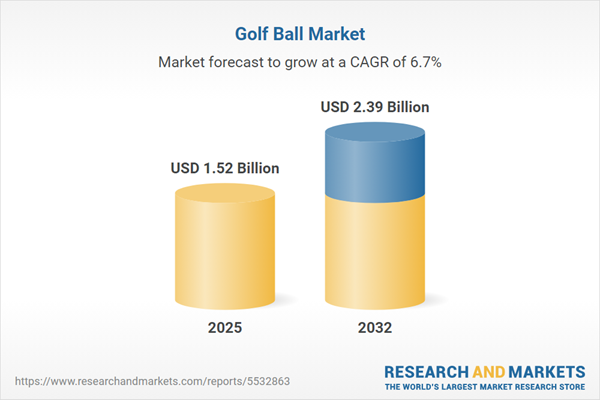Speak directly to the analyst to clarify any post sales queries you may have.
The golf ball market is undergoing a transformation, driven by rapid advances in product innovation, growing sustainability requirements, and dynamic shifts in global trade and consumer preferences. Senior leaders require a concise overview of these developments to guide investment and strategic planning in this evolving category.
Golf Ball Market Snapshot
The global golf ball market grew from USD 1.42 billion in 2024 to USD 1.52 billion in 2025. It is projected to sustain a CAGR of 6.69% through 2032, reaching USD 2.39 billion. Growth is fueled by material innovation, performance optimization, and digital retail experiences, with Asia-Pacific and the Middle East emerging as key markets alongside established demand in North America and Europe.
Scope & Segmentation in the Golf Ball Market
- Product Types: Control (four- and three-piece); Distance (multi-piece, three-piece, two-piece); Recreational (two-piece); and Tour (four- and three-piece)
- Core Materials: Ionomer (high acid, medium acid), Surlyn (hard, soft), Urethane (cast, reaction injection)
- End Users: Amateur, junior, and professional players
- Distribution Channels: Offline (pro shops, specialty golf shops, sports retailers), Online (e-commerce platforms, manufacturer websites, online marketplaces)
- Colors: White, colored (blue, red, yellow), specialty types (glow-in-the-dark, high visibility)
- Regions Covered: Americas (United States, Canada, Mexico, Brazil, Argentina, Chile, Colombia, Peru), Europe, Middle East & Africa (United Kingdom, Germany, France, Russia, Italy, Spain, Netherlands, Sweden, Poland, Switzerland, United Arab Emirates, Saudi Arabia, Qatar, Turkey, Israel, South Africa, Nigeria, Egypt, Kenya), Asia-Pacific (China, India, Japan, Australia, South Korea, Indonesia, Thailand, Malaysia, Singapore, Taiwan)
- Key Market Players: Acushnet Holdings Corp., Bridgestone Sports Co., Ltd., Callaway Golf Company, TaylorMade Golf Company, Sumitomo Rubber Industries, Ltd., Mizuno Corporation, Wilson Sporting Goods Co., Volvik, Inc., OnCore Golf Technology, LLC, Snell Sports, Inc.
Key Takeaways for Senior Decision Makers
- Performance-focused product innovation has accelerated, with manufacturers investing in advanced core designs and aerodynamics.
- Sustainability trends are influencing supplier choices and prompting the use of recyclable materials and environmentally conscious manufacturing. This is key for future regulatory compliance and brand differentiation.
- Consumer demand for color variety, digital fitting experiences, and personalized product options is creating new pathways for market engagement and online revenue growth.
- Manufacturers and retailers are adapting their product portfolios to address varying needs across amateur, junior, and professional segments, enabling more targeted inventory strategies.
- Growth opportunities in Asia-Pacific are supported by rising disposable incomes, the expansion of golf facilities, and the adoption of premium urethane balls catering to local preferences.
- Strategic partnerships, such as collaborations with professional tour players and tournament organizers, provide brands with credibility and expanded real-world testing for new technologies.
Tariff Impact on United States Golf Ball Imports
Recent adjustments to U.S. import duties have prompted companies to reassess supply chains and explore manufacturing partnerships in regions with more favorable trade terms. This has increased the importance of multi-regional sourcing and flexible logistics to avoid cost pressures and protect availability. Retailers are responding by diversifying their assortments, balancing premium offerings with locally produced alternatives to match shifting consumer price sensitivities.
Methodology & Data Sources
This report uses a mixed-methods approach, combining primary interviews with industry experts, equipment designers, and distribution partners alongside secondary reviews of patent filings, policy documents, and proprietary sales data. Quantitative market modeling is performed on validated production figures and trade data, while expert insights are continually cross-checked to ensure accuracy and actionable relevance.
Why This Report Matters
- Senior executives can leverage in-depth segmentation and technology analysis to inform product development and market entry decisions.
- Tactical guidance around supply chain adaptation empowers risk mitigation in the face of changing trade and tariff policies.
- Strategic insights enable optimized allocation of resources toward channels, regions, and user segments with the highest growth opportunity.
Conclusion
This report delivers a clear, actionable roadmap for senior decision makers navigating the dynamic golf ball market. It synthesizes technological innovation, trade impacts, and evolving consumer behaviors into strategic intelligence calibrated for long-term competitiveness.
Additional Product Information:
- Purchase of this report includes 1 year online access with quarterly updates.
- This report can be updated on request. Please contact our Customer Experience team using the Ask a Question widget on our website.
Table of Contents
3. Executive Summary
4. Market Overview
7. Cumulative Impact of Artificial Intelligence 2025
Companies Mentioned
The companies profiled in this Golf Ball market report include:- Acushnet Holdings Corp.
- Bridgestone Sports Co., Ltd.
- Callaway Golf Company
- TaylorMade Golf Company
- Sumitomo Rubber Industries, Ltd.
- Mizuno Corporation
- Wilson Sporting Goods Co.
- Volvik, Inc.
- OnCore Golf Technology, LLC
- Snell Sports, Inc.
Table Information
| Report Attribute | Details |
|---|---|
| No. of Pages | 194 |
| Published | November 2025 |
| Forecast Period | 2025 - 2032 |
| Estimated Market Value ( USD | $ 1.52 Billion |
| Forecasted Market Value ( USD | $ 2.39 Billion |
| Compound Annual Growth Rate | 6.6% |
| Regions Covered | Global |
| No. of Companies Mentioned | 11 |









